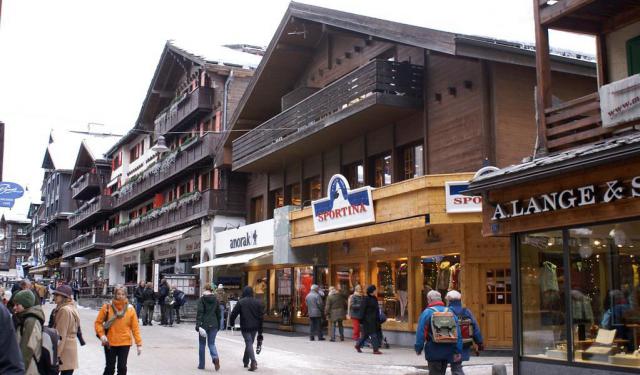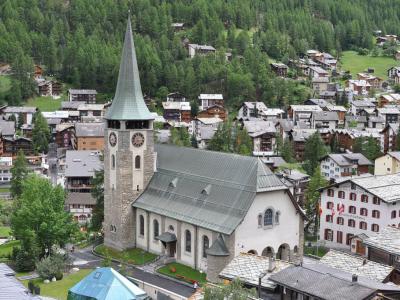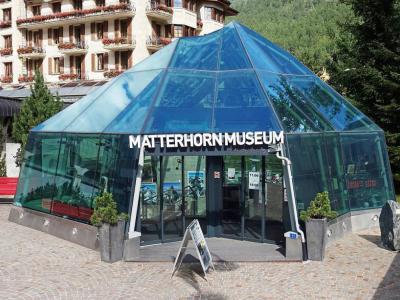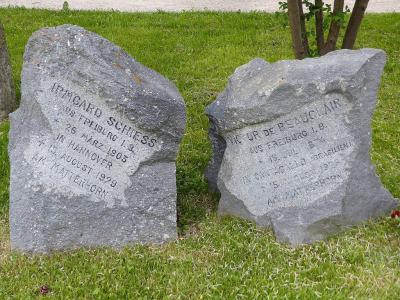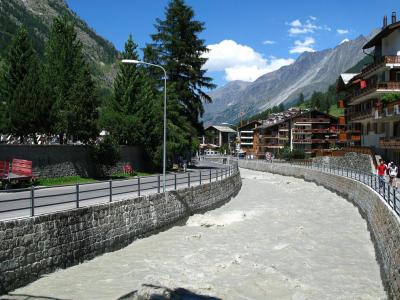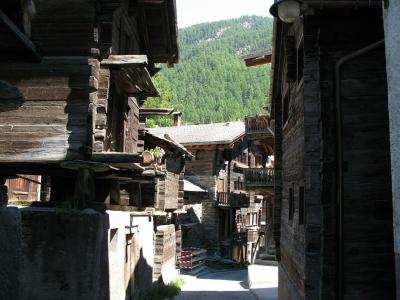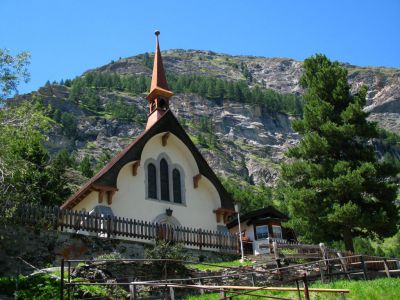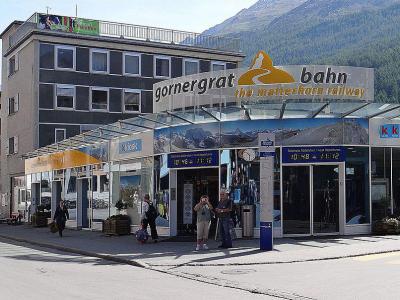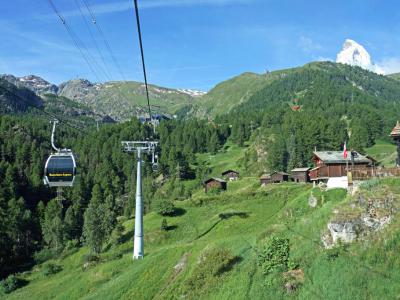Zermatt Introduction Walking Tour (Self Guided), Zermatt
Cradled at the foot of the Matterhorn mountain, whose snow-capped summit bears stoically against the sky, the small Swiss town of Zermatt is a veritable mecca for mountaineers and skiers, much as for discerning wanderers who dare to embark upon a journey of discovery.
The evidence of human habitation here dates back as far as the Bronze Age. In the Middle Ages, Zermatt was a farming village and later emerged as a trading post en route between Italy and northern Europe. Still, because of its geographical location and challenging terrain, the town remained largely isolated and relatively unknown until the mid-19th century, when mountaineering became popular.
The name Zermatt is believed to have either Celtic or German roots, possibly derived from the words “dur” (which means water) and “matten” (which means alpine meadow), referring to the numerous streams and meadows found in the valley. First documented as Zur Matte (which means "at the meadow"), the name eventually transformed into Zermatt.
In the weathered alleys of Hinterdorfstrasse, Zermatt unfurls its captivating narrative through the time-honored wooden chalets, allowing visitors a glimpse into its past. Meanwhile, the charming Church of Saint Mauritius, an architectural landmark in the town's center, adorned with centuries-old craftsmanship, imparts a sense of tranquility transcending the mundane.
For those with an affinity for the adventurous spirit, Zermatt's storied mountaineering legacy comes alive in the Matterhorn Museum, a designated repository of tales from brave pioneers who dared to scale the heavens. The Mountaineers' Cemetery pays homage to those valiant souls who sought their lofty dreams but found eternal rest amid the Alpine peaks.
The picturesque Church Bridge (Kirchbrücke) offers a stunning panorama of the Matterhorn's chiseled splendor – a popular spot for capturing postcard-perfect photos. In the lap of Saint Peter's Church, another lovely church in Zermatt, amid hushed whispers and celestial reverence, the soul finds a peaceful spot to take a moment for reflection and enjoy the serene ambiance.
Often compared to an alpine sanctuary, where surrounding peaks rise like cathedral spires and the spirit soars on the wings of desire for adventure, Zermatt is renowned for its tranquil beauty that “weaves dreams into reality.” If you wish to experience its enduring spell, then venture out on a self-guided walk to this enchanting destination without hesitation!
The evidence of human habitation here dates back as far as the Bronze Age. In the Middle Ages, Zermatt was a farming village and later emerged as a trading post en route between Italy and northern Europe. Still, because of its geographical location and challenging terrain, the town remained largely isolated and relatively unknown until the mid-19th century, when mountaineering became popular.
The name Zermatt is believed to have either Celtic or German roots, possibly derived from the words “dur” (which means water) and “matten” (which means alpine meadow), referring to the numerous streams and meadows found in the valley. First documented as Zur Matte (which means "at the meadow"), the name eventually transformed into Zermatt.
In the weathered alleys of Hinterdorfstrasse, Zermatt unfurls its captivating narrative through the time-honored wooden chalets, allowing visitors a glimpse into its past. Meanwhile, the charming Church of Saint Mauritius, an architectural landmark in the town's center, adorned with centuries-old craftsmanship, imparts a sense of tranquility transcending the mundane.
For those with an affinity for the adventurous spirit, Zermatt's storied mountaineering legacy comes alive in the Matterhorn Museum, a designated repository of tales from brave pioneers who dared to scale the heavens. The Mountaineers' Cemetery pays homage to those valiant souls who sought their lofty dreams but found eternal rest amid the Alpine peaks.
The picturesque Church Bridge (Kirchbrücke) offers a stunning panorama of the Matterhorn's chiseled splendor – a popular spot for capturing postcard-perfect photos. In the lap of Saint Peter's Church, another lovely church in Zermatt, amid hushed whispers and celestial reverence, the soul finds a peaceful spot to take a moment for reflection and enjoy the serene ambiance.
Often compared to an alpine sanctuary, where surrounding peaks rise like cathedral spires and the spirit soars on the wings of desire for adventure, Zermatt is renowned for its tranquil beauty that “weaves dreams into reality.” If you wish to experience its enduring spell, then venture out on a self-guided walk to this enchanting destination without hesitation!
How it works: Download the app "GPSmyCity: Walks in 1K+ Cities" from Apple App Store or Google Play Store to your mobile phone or tablet. The app turns your mobile device into a personal tour guide and its built-in GPS navigation functions guide you from one tour stop to next. The app works offline, so no data plan is needed when traveling abroad.
Zermatt Introduction Walking Tour Map
Guide Name: Zermatt Introduction Walking Tour
Guide Location: Switzerland » Zermatt (See other walking tours in Zermatt)
Guide Type: Self-guided Walking Tour (Sightseeing)
# of Attractions: 8
Tour Duration: 1 Hour(s)
Travel Distance: 1.8 Km or 1.1 Miles
Author: vickyc
Sight(s) Featured in This Guide:
Guide Location: Switzerland » Zermatt (See other walking tours in Zermatt)
Guide Type: Self-guided Walking Tour (Sightseeing)
# of Attractions: 8
Tour Duration: 1 Hour(s)
Travel Distance: 1.8 Km or 1.1 Miles
Author: vickyc
Sight(s) Featured in This Guide:
- St. Mauritius Church
- Matterhorn Museum
- Mountaineers' Cemetery
- Kirchbrucke (Church Bridge Viewpoint)
- Hinterdorfstrasse (Hinterdorf Street)
- St. Peter's Church
- Gornergrat Railway
- Zermatt Mountain Cable Ways
1) St. Mauritius Church (must see)
Perched in the picturesque town of Zermatt the church of Saint Mauritius stands tall as a symbol of community, history, and vibrant spiritual life. Its roots trace back centuries, and it has evolved from a modest place of worship to a magnificent testament of architectural and cultural significance. The first historical mention of the church dates back to the year 1285, hinting at a humble origin. It is believed that in its early days, the church was a small structure, barely resembling the grand edifice it is today.
Over the course of many centuries, the church underwent various expansions and renovations, each contributing to its current magnificence. The precursor to the present-day church, likely built in 1587 in an Italian architectural style, bears testament to the enduring heritage and influences that have shaped this sacred place. During the Gothic period, the church boasted three intricately crafted altars. However, the 18th-century Baroque movement led to their replacement, as was the custom of the time.
As visitors approach the church, they are treated to a breathtaking view of the majestic Matterhorn from the entrance steps. This awe-inspiring sight sets the stage for a memorable experience within its hallowed walls.
Inside the church, art enthusiasts can find an art guide to aid them in appreciating the various artistic elements that adorn the building. One such masterpiece is the ceiling painting entitled "Noah's Ark," skillfully created by Paolo Parente. This artwork captures the imagination and brings a touch of biblical history to the sacred space.
To enhance the spiritual experience, sung masses with a choir are held approximately every other Sunday and on feast days. The enchanting music resonates within the church's sacred walls, creating an atmosphere of profound reverence and devotion.
Over the course of many centuries, the church underwent various expansions and renovations, each contributing to its current magnificence. The precursor to the present-day church, likely built in 1587 in an Italian architectural style, bears testament to the enduring heritage and influences that have shaped this sacred place. During the Gothic period, the church boasted three intricately crafted altars. However, the 18th-century Baroque movement led to their replacement, as was the custom of the time.
As visitors approach the church, they are treated to a breathtaking view of the majestic Matterhorn from the entrance steps. This awe-inspiring sight sets the stage for a memorable experience within its hallowed walls.
Inside the church, art enthusiasts can find an art guide to aid them in appreciating the various artistic elements that adorn the building. One such masterpiece is the ceiling painting entitled "Noah's Ark," skillfully created by Paolo Parente. This artwork captures the imagination and brings a touch of biblical history to the sacred space.
To enhance the spiritual experience, sung masses with a choir are held approximately every other Sunday and on feast days. The enchanting music resonates within the church's sacred walls, creating an atmosphere of profound reverence and devotion.
2) Matterhorn Museum (must see)
Designed with a contemporary flair, the Matterhorn Museum weaves a compelling narrative that revolves around the early climbers who played a pivotal role in shaping the destiny of Zermatt. Dramatic excerpts from the classic film ''The Mountain Calls" (''Der Berg Ruft''), shot in Zermatt between 1937 and 1938, transport visitors back in time, evoking the spirit of adventure and courage that defined the early mountaineering era. Accompanying these cinematic marvels are a plethora of artifacts, photographs, and a detailed relief of the Matterhorn, showcasing the various routes that climbers took to reach its summit.
However, the Matterhorn Museum has much more to offer beyond the world of climbing. Step into the well-curated exhibits displaying furnishings and home interiors, providing a fascinating insight into the lives of those who called the mountains their home. These displays offer a glimpse into the essence of mountain life, revealing the unique challenges and joys that come with residing amidst the awe-inspiring alpine landscape.
But the museum's journey through time does not stop there; it delves even further into the past, unearthing artifacts and relics from the Neolithic Age. These finds bridge the gap between modern-day Zermatt and its ancient origins, allowing visitors to appreciate the historical depth and continuity of human presence in the region.
However, the Matterhorn Museum has much more to offer beyond the world of climbing. Step into the well-curated exhibits displaying furnishings and home interiors, providing a fascinating insight into the lives of those who called the mountains their home. These displays offer a glimpse into the essence of mountain life, revealing the unique challenges and joys that come with residing amidst the awe-inspiring alpine landscape.
But the museum's journey through time does not stop there; it delves even further into the past, unearthing artifacts and relics from the Neolithic Age. These finds bridge the gap between modern-day Zermatt and its ancient origins, allowing visitors to appreciate the historical depth and continuity of human presence in the region.
3) Mountaineers' Cemetery (must see)
Nestled amidst the stunning alpine landscape, the Mountaineers' Cemetery stands as a reminder that amidst the allure of adventure, safety must always remain a top priority. Visitors are urged to approach these magnificent mountains with a deep sense of caution and respect for their untamed beauty.
This hallowed ground is a sanctuary dedicated to honoring the memory of courageous climbers who lost their lives in pursuit of their passion. Around 50 gravestones, each bearing witness to a life cut short, serve as tangible memorials to the climbers who perished in the embrace of these towering peaks.
For those who venture to conquer the Matterhorn, these residual risks are a constant companion, reminding climbers of the unforgiving nature of these majestic peaks. Unfortunately, for some, the quest ends tragically, leaving behind a haunting legacy. The powerful impact of falling on exposed rock ledges often fragments the bodies of those who lose their lives, making full recovery impossible. As a result, decades later, fragments of these brave souls are occasionally discovered at the mountain's foot, their identities forever lost to the passage of time.
To honor and remember those who met their fate on the Matterhorn, the Grave of the Unknown Climber was established in the summer of 2015. This poignant site pays tribute to the 27 climbers who are still missing to this day, their stories etched in the annals of mountain history. The establishment of this memorial coincided with the 150th anniversary of the first ascent of the Matterhorn in 1865, a historic milestone in mountaineering history.
This hallowed ground is a sanctuary dedicated to honoring the memory of courageous climbers who lost their lives in pursuit of their passion. Around 50 gravestones, each bearing witness to a life cut short, serve as tangible memorials to the climbers who perished in the embrace of these towering peaks.
For those who venture to conquer the Matterhorn, these residual risks are a constant companion, reminding climbers of the unforgiving nature of these majestic peaks. Unfortunately, for some, the quest ends tragically, leaving behind a haunting legacy. The powerful impact of falling on exposed rock ledges often fragments the bodies of those who lose their lives, making full recovery impossible. As a result, decades later, fragments of these brave souls are occasionally discovered at the mountain's foot, their identities forever lost to the passage of time.
To honor and remember those who met their fate on the Matterhorn, the Grave of the Unknown Climber was established in the summer of 2015. This poignant site pays tribute to the 27 climbers who are still missing to this day, their stories etched in the annals of mountain history. The establishment of this memorial coincided with the 150th anniversary of the first ascent of the Matterhorn in 1865, a historic milestone in mountaineering history.
4) Kirchbrucke (Church Bridge Viewpoint)
The Church Bridge (Kirchbrucke) stands as a remarkable vantage point offering unparalleled views of the majestic Matterhorn. Renowned for its captivating beauty, this iconic bridge attracts visitors from far and wide, seeking to capture the essence of this natural wonder through their lenses. Whether it's the break of dawn or the enchanting hours of the night, the Church Bridge presents an ideal setting to photograph the Matterhorn in all its glory.
During the summer months, as the first light of dawn starts to break, a symphony of whispers fills the air surrounding the Church Bridge. Early morning enthusiasts and avid photographers gather at this location, eagerly selecting their perfect spot for witnessing the ultimate spectacle. Cameras and video recorders are poised, ready to capture the ethereal moment when the sun's rays grace the pinnacle of the Matterhorn with their golden touch.
As the sun ascends the sky, a mesmerizing play of light and color unfolds before the beholder's eyes. The dark silhouette of the Matterhorn gradually transforms into a vibrant canvas, bathed in warm hues and soft shades. This enchanting transformation lasts only a few minutes, creating a fleeting yet unforgettable display of nature's grandeur. It is during this magical interval that the Kirchbrücke bridge becomes an unrivaled stage for photographers, allowing them to immortalize the breathtaking beauty of the Matterhorn at its most radiant.
Beyond the spectacle of the early morning, the Church Bridge continues to offer captivating views of the Matterhorn throughout the day. On the Matterhorn's summit, a weathervane becomes visible, serving as a small but intriguing detail against the grandeur of the mountain. This subtle addition adds a touch of intrigue and character to the iconic silhouette of the Matterhorn, offering photographers an alternative subject to explore and capture.
During the summer months, as the first light of dawn starts to break, a symphony of whispers fills the air surrounding the Church Bridge. Early morning enthusiasts and avid photographers gather at this location, eagerly selecting their perfect spot for witnessing the ultimate spectacle. Cameras and video recorders are poised, ready to capture the ethereal moment when the sun's rays grace the pinnacle of the Matterhorn with their golden touch.
As the sun ascends the sky, a mesmerizing play of light and color unfolds before the beholder's eyes. The dark silhouette of the Matterhorn gradually transforms into a vibrant canvas, bathed in warm hues and soft shades. This enchanting transformation lasts only a few minutes, creating a fleeting yet unforgettable display of nature's grandeur. It is during this magical interval that the Kirchbrücke bridge becomes an unrivaled stage for photographers, allowing them to immortalize the breathtaking beauty of the Matterhorn at its most radiant.
Beyond the spectacle of the early morning, the Church Bridge continues to offer captivating views of the Matterhorn throughout the day. On the Matterhorn's summit, a weathervane becomes visible, serving as a small but intriguing detail against the grandeur of the mountain. This subtle addition adds a touch of intrigue and character to the iconic silhouette of the Matterhorn, offering photographers an alternative subject to explore and capture.
5) Hinterdorfstrasse (Hinterdorf Street) (must see)
Hinterdorf Street (Hinterdorfstrasse) is a hidden gem that captures the essence of the village's rich history. This charming street is home to a collection of unique old houses, barns, and sheds, each with its own story to tell.
The houses along Hinterdorf Street date back to the 17th and 18th centuries, showcasing the craftsmanship and design of that era. To preserve their historical significance, all the buildings in this area are protected, and any alterations or renovations are strictly regulated to ensure they adhere to the codes and guidelines of the region.
While some of these houses serve as private residences, others can be rented out for vacation stays. Many of them have undergone interior renovations to provide modern comforts, but the exteriors remain untouched, maintaining the authenticity and charm of the past. The scrutiny and regulation placed on any exterior updates ensure that the street retains its unique atmosphere and historical integrity.
One of the notable features of Hinterdorf Street is the elevated storage sheds, some of which are built on stilts. In the past, these elevated structures served as a safeguard against rodents and other unwanted guests that could compromise the food supplies stored inside. The ingenuity of this design choice reflects the resourcefulness and practicality of the villagers from centuries ago.
As you stroll down Hinterdorf Street and its neighboring streets, you'll notice a distinct lack of tourists, providing a tranquil and intimate experience. The absence of the bustling crowds from the main street allows you to immerse yourself in the surroundings and appreciate the serene ambiance. Surrounded by these well-preserved historic structures, it's easy to transport yourself back in time and envision what village life must have been like several hundred years ago.
The houses along Hinterdorf Street date back to the 17th and 18th centuries, showcasing the craftsmanship and design of that era. To preserve their historical significance, all the buildings in this area are protected, and any alterations or renovations are strictly regulated to ensure they adhere to the codes and guidelines of the region.
While some of these houses serve as private residences, others can be rented out for vacation stays. Many of them have undergone interior renovations to provide modern comforts, but the exteriors remain untouched, maintaining the authenticity and charm of the past. The scrutiny and regulation placed on any exterior updates ensure that the street retains its unique atmosphere and historical integrity.
One of the notable features of Hinterdorf Street is the elevated storage sheds, some of which are built on stilts. In the past, these elevated structures served as a safeguard against rodents and other unwanted guests that could compromise the food supplies stored inside. The ingenuity of this design choice reflects the resourcefulness and practicality of the villagers from centuries ago.
As you stroll down Hinterdorf Street and its neighboring streets, you'll notice a distinct lack of tourists, providing a tranquil and intimate experience. The absence of the bustling crowds from the main street allows you to immerse yourself in the surroundings and appreciate the serene ambiance. Surrounded by these well-preserved historic structures, it's easy to transport yourself back in time and envision what village life must have been like several hundred years ago.
6) St. Peter's Church
Saint Peter's Church, also known as the English Church, stands as a symbol of the town's history and enduring ties to British visitors. This sacred place has been intertwined with the rich tapestry of Zermatt's past, playing a significant role in the resort's development and representing the golden age of alpinism. British visitors were among the first to venture to this alpine wonderland, and Saint Peter's Church became an essential institution for the English-speaking community.
The idea to build an English church took shape in May 1865, and a donation list was initiated shortly thereafter. Notably, the Catholic hoteliers Alexander Seiler and Joseph Clemenz were among the first to contribute, highlighting their ecumenical and inclusive views. The tragic event of the first ascent of the Matterhorn, where several climbers lost their lives, including Lord Francis Douglas, Douglas R. Hadow, and the Reverend Charles Hudson, did not deter the initiative but rather intensified the resolve to create the church.
On 29 June 1869, a mere five years after the inception of the donation list, the foundation stone for Saint Peter's Church was laid. Within a year, on 29 June 1870, the inaugural service took place, marking the beginning of the church's storied existence.
Inside this historic sanctuary, numerous plaques serve as touching memorials to mountaineers who shared deep bonds with Zermatt and its alpine wonders. Among them lies the remains of the Reverend Charles Hudson, buried beneath the main altar, a poignant reminder of his enduring connection to this sacred space.
The idea to build an English church took shape in May 1865, and a donation list was initiated shortly thereafter. Notably, the Catholic hoteliers Alexander Seiler and Joseph Clemenz were among the first to contribute, highlighting their ecumenical and inclusive views. The tragic event of the first ascent of the Matterhorn, where several climbers lost their lives, including Lord Francis Douglas, Douglas R. Hadow, and the Reverend Charles Hudson, did not deter the initiative but rather intensified the resolve to create the church.
On 29 June 1869, a mere five years after the inception of the donation list, the foundation stone for Saint Peter's Church was laid. Within a year, on 29 June 1870, the inaugural service took place, marking the beginning of the church's storied existence.
Inside this historic sanctuary, numerous plaques serve as touching memorials to mountaineers who shared deep bonds with Zermatt and its alpine wonders. Among them lies the remains of the Reverend Charles Hudson, buried beneath the main altar, a poignant reminder of his enduring connection to this sacred space.
7) Gornergrat Railway
As the highest open-air train station in Switzerland and the second highest railway in all of Europe, the Gornergrat Railway is a marvel of engineering that has been delighting tourists since 1898. A feat of Swiss precision and innovation, this electric railway gracefully transports visitors high into the heart of the mountains, offering a once-in-a-lifetime opportunity to witness the breathtaking splendor that surrounds Zermatt.
As the train chugs along, you'll find yourself surrounded by an awe-inspiring array of 29 peaks, each majestically rising above 4,000 meters. The scenery that unfolds before your eyes is nothing short of a natural wonder, leaving you humbled by the grandeur of the Swiss Alps.
Arriving at the Gornergrat Railway's highest station, you'll step into a world of wonder, where the air is crisp and the vistas are boundless. It's as though you've been transported to a place that exists somewhere between reality and dreams.
The station square that greets you at the top is a bustling hub of activity, alive with the energy of adventurous souls eager to explore this alpine wonderland. Here, you'll discover charming tea-rooms and cafes with inviting terraces, where you can savor local delicacies and refreshments while taking in the mesmerizing views that surround you.
As the train chugs along, you'll find yourself surrounded by an awe-inspiring array of 29 peaks, each majestically rising above 4,000 meters. The scenery that unfolds before your eyes is nothing short of a natural wonder, leaving you humbled by the grandeur of the Swiss Alps.
Arriving at the Gornergrat Railway's highest station, you'll step into a world of wonder, where the air is crisp and the vistas are boundless. It's as though you've been transported to a place that exists somewhere between reality and dreams.
The station square that greets you at the top is a bustling hub of activity, alive with the energy of adventurous souls eager to explore this alpine wonderland. Here, you'll discover charming tea-rooms and cafes with inviting terraces, where you can savor local delicacies and refreshments while taking in the mesmerizing views that surround you.
8) Zermatt Mountain Cable Ways
In November 2018, Zermatt welcomed a remarkable addition to its mountain transportation network-the new 3S cableway, a feat of engineering that operates year-round and carries up to an astounding 2000 passengers per hour to the Matterhorn Glacier Paradise. This awe-inspiring cableway, known as the Matterhorn Glacier Ride l, proudly claims the title of the world's highest 3S cableway, linking Trockener Steg to Matterhorn Glacier Paradise at an impressive altitude of 3883 meters. Together with the existing Matterhorn-Express cable car, this state-of-the-art 3S cableway enables passengers to swiftly and comfortably ascend from Zermatt, located at 1608 meters, to Europe's highest mountain station.
The cableway allows the seamless journey from the charming Matterhorn village of Zermatt to Breuil-Cervinia in Italy without having to set foot in snow or water. The panoramic journey, spanning around one hour from Switzerland to Italy or vice versa, offers an extraordinary experience as passengers traverse an astonishing altitude difference of over 4,000 meters-the most significant change of any cableway on the continent. As travelers soar towards the heavens, they are treated to unparalleled vistas of the Swiss Alps and the iconic Matterhorn, a sight that captures the essence of natural beauty.
The station's shell boasts a wooden construction, ensuring both the stability of the mountain station and an aesthetic, welcoming ambiance. The warm and inviting atmosphere complements the breathtaking views, creating an unforgettable experience for all who visit.
The cableway allows the seamless journey from the charming Matterhorn village of Zermatt to Breuil-Cervinia in Italy without having to set foot in snow or water. The panoramic journey, spanning around one hour from Switzerland to Italy or vice versa, offers an extraordinary experience as passengers traverse an astonishing altitude difference of over 4,000 meters-the most significant change of any cableway on the continent. As travelers soar towards the heavens, they are treated to unparalleled vistas of the Swiss Alps and the iconic Matterhorn, a sight that captures the essence of natural beauty.
The station's shell boasts a wooden construction, ensuring both the stability of the mountain station and an aesthetic, welcoming ambiance. The warm and inviting atmosphere complements the breathtaking views, creating an unforgettable experience for all who visit.
The Most Popular Cities
/ view all
